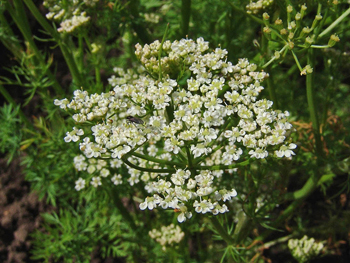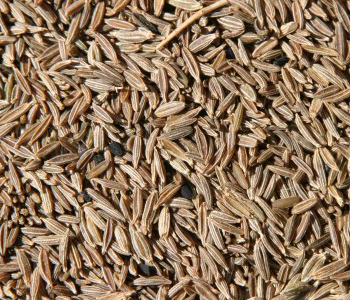Contents:
Common Names | Parts Usually Used | Plant(s) & Culture | Where Found | Medicinal Properties | Biochemical Information
Legends, Myths and Stories | Uses | Formulas or Dosages | Nutrient Content | How Sold | Warning | Bibliography
Scientific Names

- Carum carvi L.
- Apiaceae
- Umbelliferae
- Umbel family
Common Names
- Caraway seed
- Caraway fruit
Parts Usually Used
Seed
Back to Top

Description of Plant(s) and Culture
Caraway is a biennial or perennial plant; the hollow, furrowed, angular, branched stem grows in the second year from a white, carrot-shaped root. The leaves are bi- or tripinnate and deeply incised, carrot-like, the upper ones on a sheath-like petiole. The small white or yellow flowers grow in compound umbels, with 5-12 very unequal stalks, outer flowers larger than inner ones, appear in May and June, forming a compound umbel with rays of unequal length. The fruit is dark brown, oblong, flattened, and two-seeded. Strongly scented when rubbed. Full sun to light shade. Zones 3-4.
Back to Top

Where Found
Cultivated and found wild in the northern and northwestern United States, Europe, and Asia. Seen growing as a weed in waste places from Newfoundland to Alberta and south to Pennsylvania and Colorado. Native to Eurasia.
Back to Top
Medicinal Properties
Antispasmodic, appetizer, carminative, emmenagogue, expectorant, galactagogue, stomachic.
Back to Top
Biochemical Information
Essential oil with arvene and limonene, fatty oil with linoleic, oleic and petroselinic acids, nitrogenous materials, tannins, coumarins, resin.
Back to Top
Legends, Myths and Stories
The famous Ebers Papyrus, an ancient Egyptian scroll containing medical notes and recipes from 1550 BC, lists 20 plants used as both medicines and seasonings, including anise, fennel, thyme, mustard, wormwood, and caraway. From this we know that caraway has been in use for at least 3500 years. The medicinal effect of caraway is due principally to the carvon contained in the essential oil.
Dioscorides advised the oil of caraway for pale-faced girls.
Caraway was an ingredient in love potions as well as an additive to the feed of homing fowl. And true believers held that any object that contained a few caraway seeds would be safe from theft; if any thief tried to steal such an object, the staying power of caraway would seize and hold him on the spot until the owner reached the scene.
The 17th century herbalist advised: The roots of caraway, being boiled, may be eaten as carrots.
The oil of caraway is used for making Kummel and L’huile de Venus and other cordials. Kummel is used as a digestive. A vodka-like Scandinavian liquor is made with grain or potatoes and flavored with oil of caraway. Like vodka, it is served “on the rocks.”
Back to Top
Uses
Like many other common kitchen spices, caraway has a beneficial effect on the appetite and digestion. It promotes the onset of menstruation, relieves uterine cramps, promotes the secretion of milk, god for inflammations, and is mildly expectorant. Use caraway for flatulent colic, particularly in infants, coughs, pleurisy, colds, and also as a stomach settler after taking nauseous medicines. Use as a poultice for bruises. Use as a wash for rheumatism.
Seeds have a characteristic, pungent flavor; use cautiously because the flavor is strong and turns bitter with long cooking.
Used as a flavoring for vermouth.
Its more obvious uses in the United States include flavoring rye bread. Is the base for a German liqueur called “Kummel”, which is a syrupy, clear, and colorless coffee-time delight with a strong and pungent bouquet of caraway.
Back to Top
Formulas or Dosages
The seeds may be chewed as is or the following preparations used:
Infusion: use 3 tsp. crushed seeds with 1/2 cup water.
Decoction: use 1 tsp. seeds to 1/2 cup water. Boil briefly, steep covered for 10 minutes and strain. Take 1 to 1 1/2 cups a day, a mouthful at a time. Or boil 3 tsp. seeds in 1/2 cup milk for a short time, then steep for 10 minutes.
Oil: take 3-4 drops of caraway oil, 3 times a day.
Powder: take 1/4 to 1/2 tsp., 2-3 times a day.
Back to Top
Nutrient Content
Phosphorus
Back to Top
How Sold
Seeds, seed oil
Back to Top
Warning
Never give seeds to infants or young children; give extract.
Caraway (to some, considered of the carrot family) is very much like the carrot foliage, which includes many poisonous species that can be easily mistaken for this plant. For this reason, do not collect wild caraway under any circumstances!
Caraway, in appearance, is very similar to fool’s parsley and poison hemlock.
Back to Top
Bibliography
![]() Back to Eden
Back to Eden, by Jethro Kloss; Back to Eden Publishing Co., Loma Linda, CA 92354, Original copyright 1939, revised edition 1994
![]() The Herb Book
The Herb Book, by John Lust, Bantam Books, 666 Fifth Avenue, New York, NY. copyright 1974.
![]() Eastern/Central Medicinal Plants
Eastern/Central Medicinal Plants, by Steven Foster and James A. Duke., Houghton Mifflin Company, 215 Park Avenue South, New York, NY 10000
![]() The Nature Doctor: A Manual of Traditional and Complementary Medicine
The Nature Doctor: A Manual of Traditional and Complementary Medicine, by Dr. H.C.A. Vogel; Keats Publishing, Inc., 27 Pine Street (Box 876) New Canaan, CT. 06840-0876. Copyright Verlag A. Vogel, Teufen (AR) Switzerland 1952, 1991
![]() Indian Herbalogy of North America
Indian Herbalogy of North America, by Alma R. Hutchens, Shambala Publications, Inc., Horticultural Hall, 300 Massachusetts Avenue, Boston, Massachusetts 02115, 1973
![]() The Herbalist Almanac
The Herbalist Almanac, by Clarence Meyer, Meyerbooks, publisher, PO Box 427, Glenwood, Illinois 60425, copyright 1988, fifth printing, 1994
![]() Culpeper’s Complete Herbal & English Physician: Updated With 117 Modern Herbs
Culpeper’s Complete Herbal & English Physician: Updated With 117 Modern Herbs, by Nicholas Culpeper, Meyerbooks, publisher, PO Box 427, Glenwood, Illinois 60425, 1990, (reprint of 1814)
Herbal Gardening, compiled by The Robison York State Herb Garden, Cornell Plantations, Matthaei Botanical Gardens of the University of Michigan, University of California Botanical Garden, Berkeley., Pantheon Books, Knopf Publishing Group, New York, 1994, first edition
 Old Ways Rediscovered
Old Ways Rediscovered, by Clarence Meyer, Meyerbooks, publisher, PO Box 427, Glenwood, Illinois 60425, published from 1954, print 1988
 Earl Mindell’s Herb Bible
Earl Mindell’s Herb Bible, by Earl Mindell, R.Ph., Ph.D., Simon & Schuster/Fireside, Rockefeller Center 1230 Avenue of the Americas, New York, New York 10020
![]() Planetary Herbology
Planetary Herbology, by Michael Tierra, C.A., N.D., O.M.D., Lotus Press, PO Box 325, Twin Lakes. WI 53181., Copyright 1988, published 1992
![]() American Folk Medicine
American Folk Medicine, by Clarence Meyer, Meyerbooks, publisher, PO Box 427, Glenwood, Illinois 60425, 1973
![]() Webster’s New World Dictionary
Webster’s New World Dictionary, Third College Edition, Victoria Neufeldt, Editor in Chief, New World Dictionaries: A Division of Simon & Schuster, Inc., 15 Columbus Circle, New York, NY 10023
 An Instant Guide to Medicinal Plants
An Instant Guide to Medicinal Plants, by Pamela Forey and Ruth Lindsay, Crescent Books (January 27, 1992).
 The Magic of Herbs in Daily Living
The Magic of Herbs in Daily Living, by Richard Lucas, Parker Publishing Co. (1988).
 The Healing Plants
The Healing Plants, by Mannfried Pahlow, Barron’s Educational Series, Inc. 250 Wireless Blvd., Hauppauge, NY 11788, 1992
![]() The Yoga of Herbs: An Ayurvedic Guide to Herbal Medicine
The Yoga of Herbs: An Ayurvedic Guide to Herbal Medicine, by Dr. David Frawley & Dr. Vasant Lad, Lotus Press, Twin Lakes, Wisconsin, Second edition, 1988.
 The Rodale Herb Book: How to Use, Grow, and Buy Nature’s Miracle Plants (An Organic gardening and farming book)
The Rodale Herb Book: How to Use, Grow, and Buy Nature’s Miracle Plants (An Organic gardening and farming book), edited by William H. Hylton, Rodale Press, Inc. Emmaus, PA, 18049., 1974
